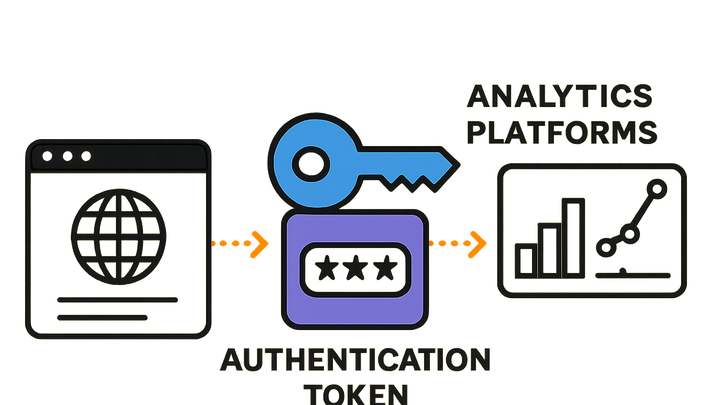Published on 2025-06-26T04:16:01Z
What is an Authentication Token? Examples in Analytics
An Authentication Token is a secure credential used in analytics to authenticate and authorize data requests between clients and analytics servers. It verifies that incoming data streams or API calls are from authorized sources, ensuring data integrity and preventing unauthorized data injection. Tokens can take various forms, such as API keys, JSON Web Tokens (JWTs), or opaque strings, and often include embedded claims, scopes, or expiry timestamps.
In analytics platforms like GA4, tokens (e.g., API secrets) allow developers to use the Measurement
Protocol to send events directly to Google Analytics. In PlainSignal, attributes like data-id
in the tracking snippet act as tokens that validate and route data to the correct account. Proper
management, rotation, and scope-limiting of tokens are essential for maintaining security, compliance, and
reliable data collection.
Authentication token
A credential used to authenticate and authorize analytics API requests, ensuring secure and reliable data collection.
Why Authentication Tokens Matter in Analytics
Authentication tokens are fundamental to securing analytics workflows. They ensure only authorized clients can send or retrieve data, prevent malicious data injection, and uphold compliance with data protection regulations. Without proper authentication, analytics endpoints could be abused, leading to polluted datasets and potential privacy breaches.
-
Prevent unauthorized data submission
Tokens verify the identity of data senders. By validating tokens at the endpoint, analytics platforms can reject requests from unknown or tampered clients.
-
Data integrity
Ensures events originate from legitimate sources, preserving the accuracy of insights.
-
Access management
Allows administrators to revoke or rotate tokens without changing application code.
-
-
Control api access and quotas
Tokens help manage rate limits and usage quotas by identifying clients and applying policies at the token level.
-
Usage tracking
Associate usage metrics with specific tokens to monitor consumption and detect anomalies.
-
Scoped permissions
Grant tokens limited permissions, such as read-only or event submission only.
-
How Authentication Tokens Work
Authentication tokens typically involve generation by a server, secure storage by clients, and validation by analytics APIs. The process usually includes time-limited or revocable tokens to mitigate risks, as well as optional embedded claims for granular control.
-
Token generation
Servers create tokens using cryptographic algorithms or unique opaque strings. They may embed metadata such as expiry timestamps or scopes.
-
Jwts vs opaque tokens
JWTs carry payload data and verify integrity via signatures, while opaque tokens rely on server-side lookups.
-
One-time vs refreshable
Short-lived tokens reduce risk, refreshed via long-lived credentials when needed.
-
-
Token transmission
Clients include tokens in HTTP headers, URL parameters, or script attributes when sending analytics data.
-
Header-based
Common in server-to-server calls, e.g.,
Authorization: Bearer <token>. -
Url parameter
Used in some tracking snippets or measurement protocol requests.
-
-
Token validation
Analytics endpoints verify token integrity, expiry, and scopes before accepting data or fulfilling requests.
-
Signature verification
For JWTs, the signature ensures the token hasn’t been tampered with.
-
Server lookup
Opaque tokens are validated by checking against a database of active tokens.
-
Authentication Tokens in Popular Analytics Platforms
Below are examples of how authentication tokens or equivalent credentials are used in PlainSignal and Google Analytics 4 to secure data collection.
-
PlainSignal implementation
In PlainSignal’s cookie-free analytics, the
data-idattribute in the tracking snippet acts as the authentication token, identifying and validating the data source.-
Tracking snippet
Include your unique site token in the
data-idattribute:<link rel="preconnect" href="//eu.plainsignal.com/" crossorigin /><script defer data-do="yourwebsitedomain.com" data-id="0GQV1xmtzQQ" data-api="//eu.plainsignal.com" src="//cdn.plainsignal.com/plainsignal-min.js"></script> -
Server-side validation
PlainSignal verifies the
data-idagainst its database before accepting any event data.
-
-
GA4 measurement protocol
Google Analytics 4 uses
measurement_idandapi_secretas authentication credentials for server-to-server event collection. These tokens ensure only authorized event requests are processed.-
Http request example
POST https://www.google-analytics.com/mp/collect?measurement_id=G-XXXXXXXXXX&api_secret=YOUR_API_SECRET Content-Type: application/json { "client_id": "123456789.123456789", "events": [ {"name": "page_view", "params": {"page_title": "Homepage"}} ] } -
Secret management
Store
api_secretin secure environment variables or secret managers to prevent exposure.
-
Best Practices for Managing Authentication Tokens
Implementing strong token management policies helps maintain data security, compliance, and service reliability across analytics pipelines.
-
Secure storage
Keep tokens out of source code and client-side storage to prevent unauthorized access.
-
Environment variables
Store tokens in server environment variables to limit exposure.
-
Secret management tools
Use services like AWS Secrets Manager, HashiCorp Vault, or GCP Secret Manager.
-
-
Regular rotation and revocation
Rotate tokens on a schedule and revoke them immediately if compromised.
-
Automated rotation
Set up lifecycle policies to auto-rotate tokens periodically.
-
Immediate revocation
Invalidate tokens upon detecting suspicious activity or breaches.
-
-
Principle of least privilege
Issue tokens with the minimum permissions necessary for their use case.
-
Fine-grained scopes
Limit tokens to specific actions such as
event:writeordata:read. -
Contextual access
Use separate tokens for development, staging, and production environments.
-
